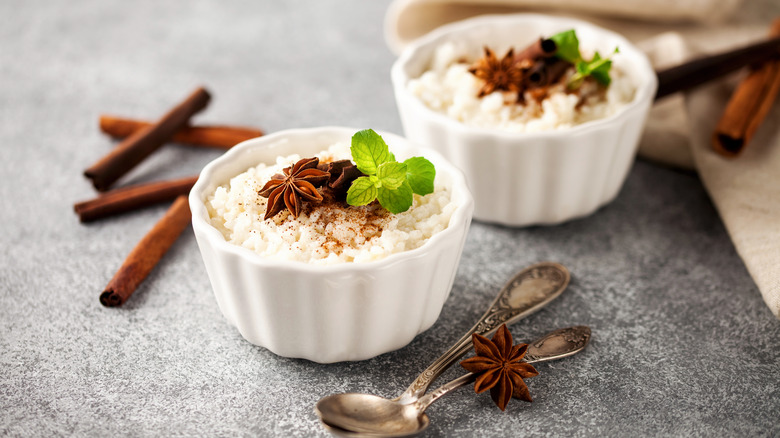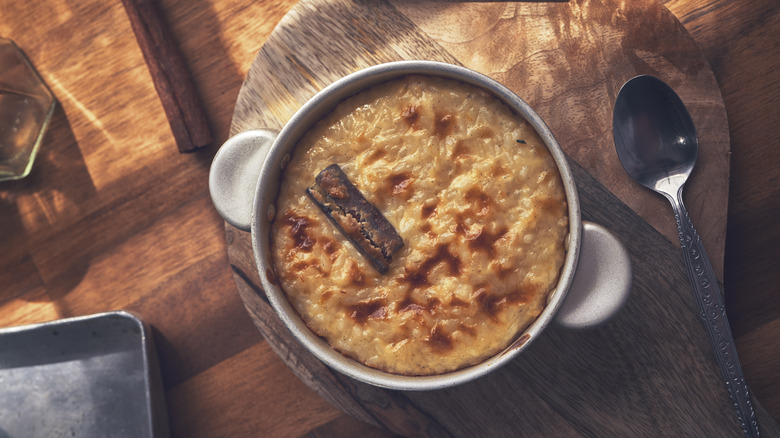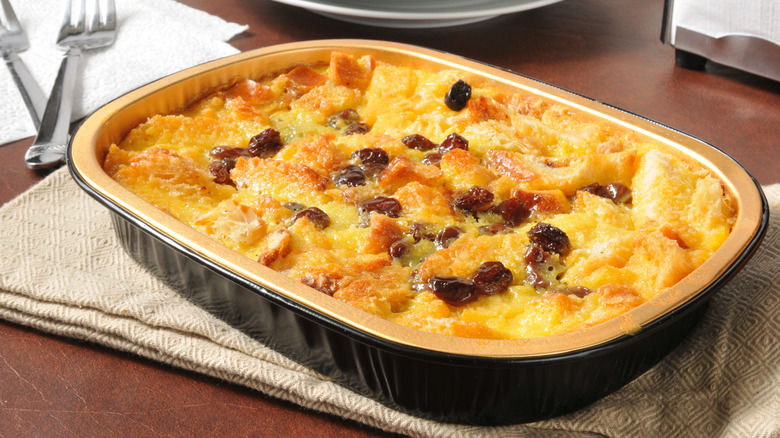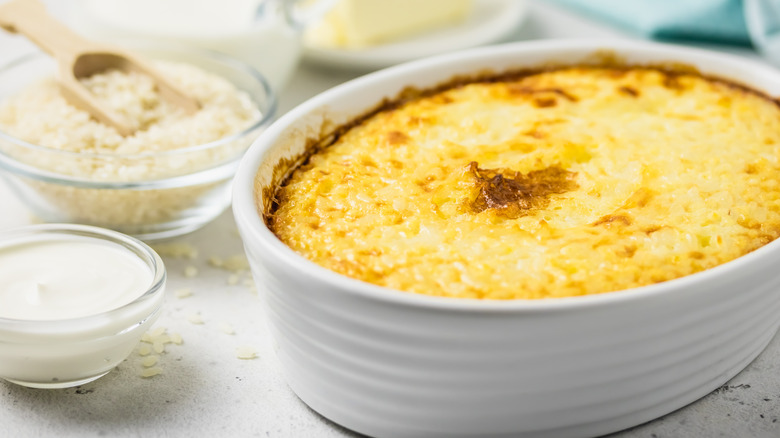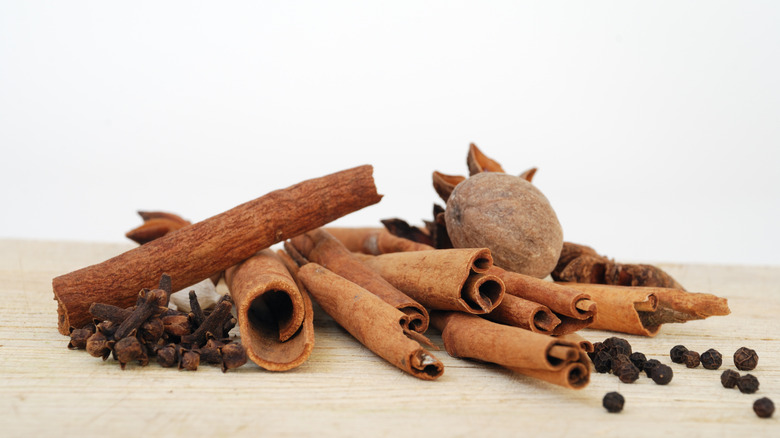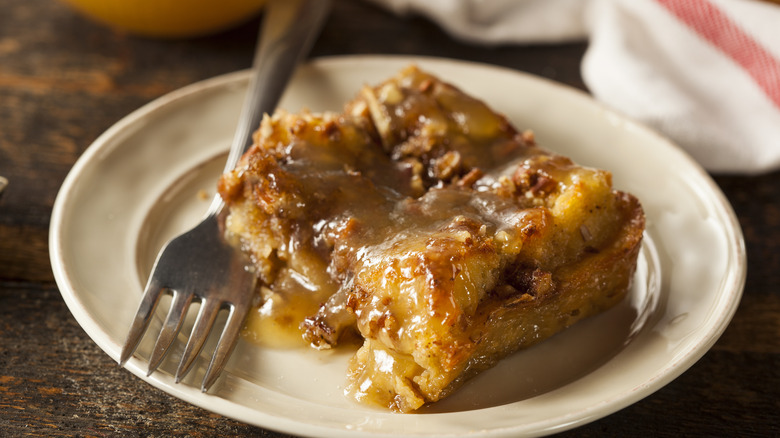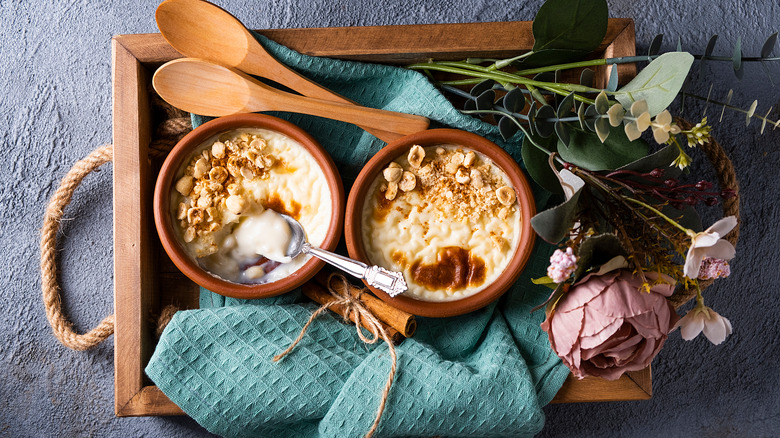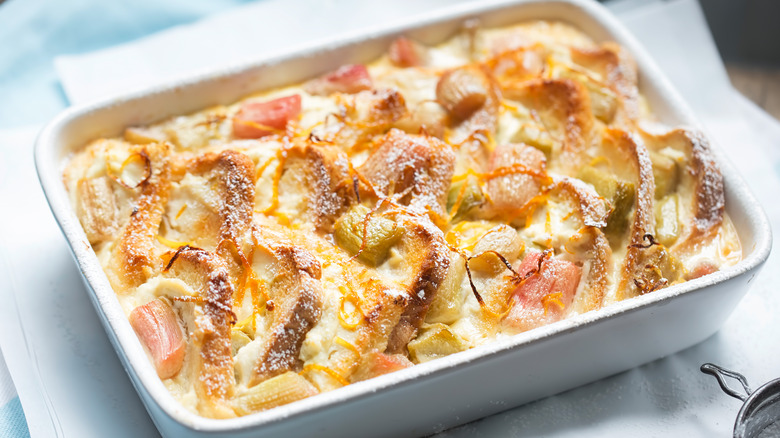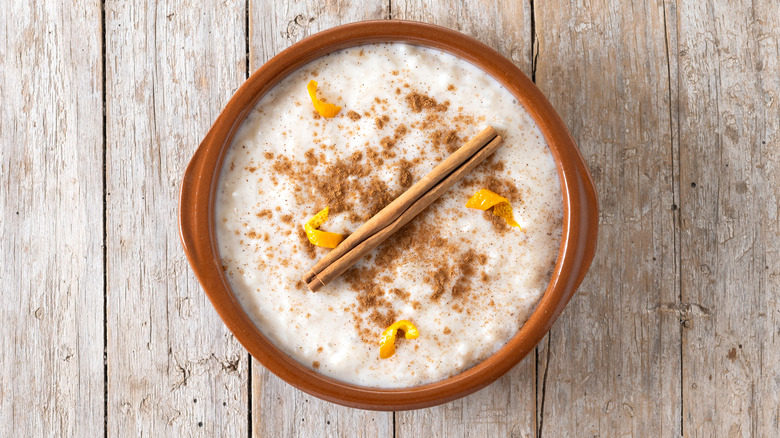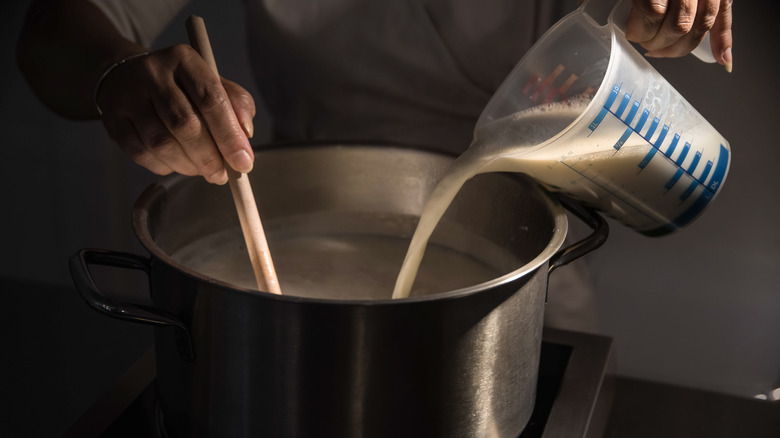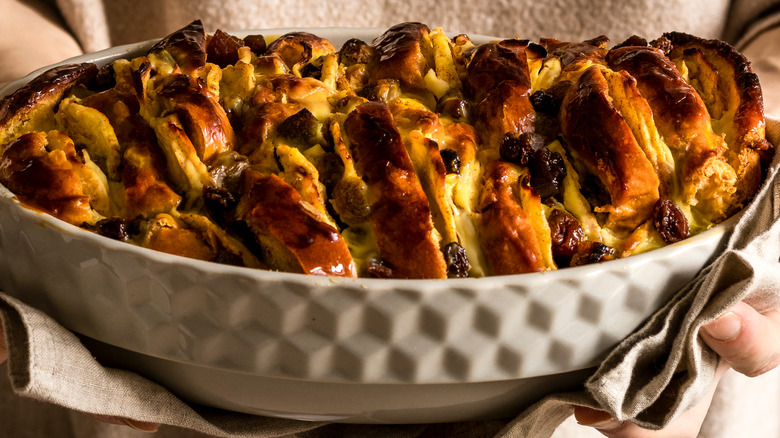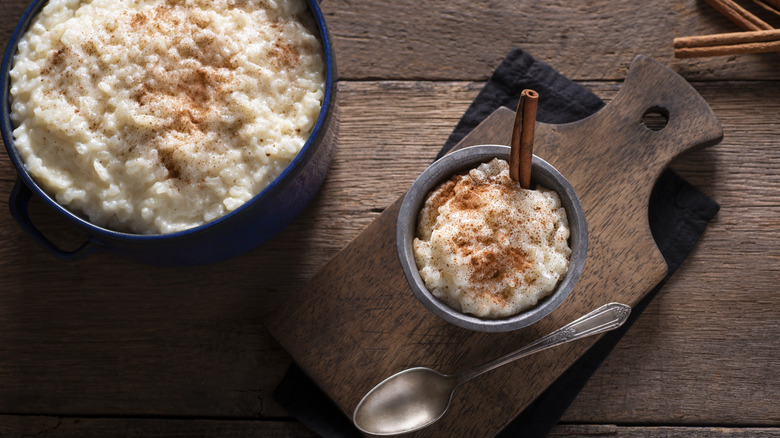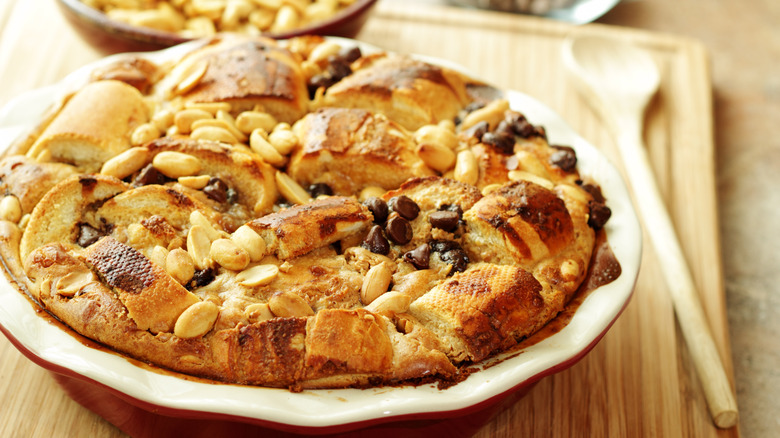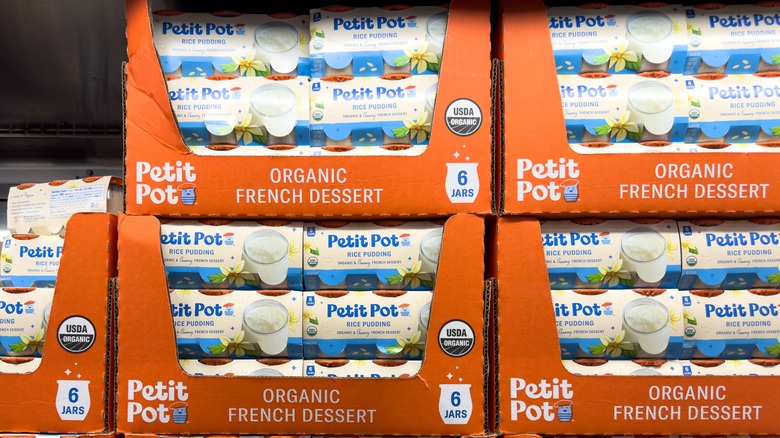Rice Pudding Vs Bread Pudding: Everything You Need To Know
Bread pudding and rice pudding are both traditional, comforting desserts, each with its own loyal following and charm. These puddings have been cherished for generations and found on tables across cultures. Obviously, the two are quite different but they also fit into a similar category, so you might be wondering about how rice pudding and bread pudding compare.
Rice pudding, a velvety concoction of rice, milk, and sugar, has been a staple in various global cuisines. Its origins are as diverse as its many variations, ranging from the creamy arroz con leche in Latin America to the fragrant kheer in South Asia. The simple yet sublime blend of ingredients creates a dessert that manages to be both soothing and indulgent, making it a favorite for cozy nights or festive occasions.
On the flip side, bread pudding enters the scene with a humble demeanor but packs a flavorful punch. Born out of the ingenious idea of repurposing stale bread, this dessert transforms ordinary ingredients into something special. Bread pudding is a canvas for creativity, with bakers infusing their own twists, from classic raisin-studded versions to innovative interpretations featuring chocolate, fruits, or even savory elements.
In this exploration of rice pudding versus bread pudding, we'll dive into the preparation methods and distinctive characteristics that set these desserts apart. We've got all the information you need about both. So, whether you're deciding which to have for dessert or just curious, we have everything you need to know right here.
What is rice pudding?
Rice pudding is a classic dessert that transcends cultural boundaries, with variations found in cuisines around the globe. At its core, rice pudding is a velvety sweet dish crafted from a blend of rice, milk, and sugar. This beloved dessert can be enjoyed warm or chilled, making it versatile for various occasions and personal preferences. The rice, when cooked to perfection, contributes a soft, tender texture, while the milk imparts a rich and decadent creaminess. The sweetness level can be adjusted to suit individual tastes, creating a dessert that can range from mildly sweet to indulgently sugary.
Rice pudding comes in two broad categories: baked rice pudding and stovetop rice pudding. Baked rice pudding is prepared by combining the ingredients and then baking the mixture until the rice is tender and the top develops a golden-brown crust. This method imparts a slightly firmer texture to the dessert. On the other hand, stovetop rice pudding involves cooking the ingredients on the stove, stirring them until the rice is cooked and the mixture thickens to the desired consistency. This method results in a creamier and softer pudding, with the rice grains seamlessly blending into the rich milk base.
What is bread pudding?
Bread pudding is a home-style dessert that's made with humble ingredients but still manages to taste amazing. Bread pudding is a surprisingly delicious combination of stale or leftover bread, milk, sugar, and eggs, resulting in a dessert that showcases the beauty of resourcefulness and creativity in the kitchen.
This classic pudding turns ordinary, often overlooked ingredients into something greater than the sum of its parts. Stale bread is given a new lease on life as it soaks up a luscious mixture of milk, sugar, and beaten eggs. When cooked in the oven, it essentially becomes a baked custard, intermingled with softened bread. We especially love its versatility. While the classic bread pudding recipe is a simple one, there are so many ways to customize it and mix things up.
Baked to golden perfection, bread pudding emerges from the oven with a tantalizing aroma and a visually appealing golden-brown crust. Its simplicity and adaptability make it a go-to dessert for both casual family dinners and more formal occasions. It's a dessert that celebrates the beauty of thriftiness and the art of transforming leftovers into something extraordinary.
What are the main ingredients?
Rice pudding has a few main ingredients: rice, milk, and sugar. The type of rice used can vary, with popular choices including short-grain rice, arborio rice, or jasmine rice, each lending its own unique texture to the final dish. Short-grain rice, for example, tends to result in a creamier pudding due to its higher starch content.
In various cultural variations of rice pudding, different types of rice may be preferred. For instance, arborio rice is common in Italian rice pudding, contributing to its creamy consistency. In South Asian cuisine, basmati or any local variety of aromatic rice is often the rice of choice for making traditional rice puddings like kheer. While the classic recipe involves the use of dairy milk, rice pudding can be adapted to dietary preferences by incorporating non-dairy alternatives.
A classic bread pudding contains a blend of simple ingredients, each contributing to its rich and comforting flavor. Stale or day-old bread is the star of the show. The bread is usually cubed or torn into pieces, providing the base and texture for the pudding. Milk is an essential component, forming part of the creamy custard that binds the bread together. Whole milk is often used for its richness, but variations can include heavy cream or a mixture of milk and cream for added decadence. Eggs are also essential for the custard. Then, there's sugar and vanilla added to sweeten and flavor the pudding. Additional ingredients may include dried fruits, butter, and spices.
How are they flavored?
The spices used in rice pudding can vary widely depending on cultural traditions and personal preferences. However, some spices are commonly found in rice pudding recipes, adding warmth and depth to what might otherwise be a one-note dessert. Cinnamon and nutmeg are perhaps the two most ubiquitous spices in rice pudding. Cinnamon imparts a familiar warmth, while nutmeg brings nuttiness and sweetness. There are other spices you might find in rice pudding. Cardamom is commonly found in rice puddings from South Asian and Middle Eastern cuisines, and offers a fragrant, citrusy, and slightly peppery note. It's also not unheard of to find spices such as allspice and cloves in rice pudding. Vanilla is often added to rice pudding to enhance its overall flavor. Vanilla extract or vanilla bean can be incorporated into the milk mixture for a sweet and aromatic touch.
Bread pudding generally contains similar sweet spices. Nutmeg and cinnamon are arguably the most common, but anything you might find in a Christmas cookie or a pumpkin spice latte wouldn't be a leftfield choice. Cloves, allspice, cardamom, and even a hint of ginger are all on the table. Like rice pudding, bread pudding usually contains vanilla. This helps to flavor the custard.
Are their textures different?
The texture of rice pudding is a key element of its overall appeal, and it can vary based on factors such as the cooking method and specific recipe. In general, rice pudding is known for its creamy consistency. The rice contributes a slight chewiness to each spoonful. However, the textural differences between stovetop rice pudding and baked rice pudding are noteworthy. Stovetop versions usually have a creamier texture compared to their baked counterparts. They often involve a shorter cooking time, resulting in a softer, looser consistency. The pudding is continuously stirred to prevent sticking and to ensure even cooking.
Baked rice pudding, as the name suggests, is prepared by baking the ingredients in the oven. This method yields a firmer texture compared to stovetop versions. The rice grains absorb the liquid during baking, and the long cooking time can lead to a pleasantly stodgy consistency. Baking causes a golden-brown skin to form on the top of the pudding, which contrasts the creaminess beneath.
True to its name, bread pudding has a soft, pudding-like consistency. The bread pieces soak up the custard mixture during the preparation, becoming moist and tender as they bake. The bread essentially transforms into a sponge for the custard, creating a delicate, melt-in-your-mouth texture. The custard, made from a mixture of milk, eggs, and sugar, binds the bread together, giving it a dense yet creamy texture. It isn't quite as loose in texture as rice pudding, particularly stovetop versions.
What do they taste like?
Rice pudding has a mild flavor. The core of the flavor comes from milk and rice, both of which have subtle flavors. It's sweet due to the addition of sugar, but sugar levels and sweetness can vary depending on the recipe. Many rice pudding recipes include vanilla extract or vanilla bean, adding a warm and aromatic note to the overall flavor profile. Vanilla enhances the sweetness and richness of the dessert. Common spices like cinnamon and nutmeg are frequently used, providing an additional layer of flavor. Depending on cultural influences, additional aromatic elements such as cardamom, star anise, or orange blossom water may be incorporated, giving the rice pudding a unique and regional character.
Bread pudding tastes quite custardy. This is because of the custard base, which contains eggs, milk or cream, and vanilla. The choice of vanilla — whether a cheap extract or real vanilla beans — can have a big impact on the flavor. It's also lightly spiced, often with nutmeg and cinnamon, and these flavors come through. You also get some flavor from the bread, so your choice of bread matters. Some variations use other types of breads and baked goods, such as challah or croissants, but we'll delve into variations more later. Some recipes include dried fruit or chocolate chips, so this adds more flavor.
What do they smell like?
Rice pudding has a pleasant aroma that is often infused with sweet, creamy, and sometimes spiced notes. The specific scent can vary depending on the recipe, cooking method, and any additional flavorings used. The presence of sugar in rice pudding contributes to a sweet aroma that is inviting and comforting. The use of milk or a milk alternative in rice pudding adds a creamy note to the smell. Then you have the rice — its aroma can be discernible, especially if it's a fragrant variety like basmati. On top of this, you get the scent of spices and other flavorings. Depending on the recipe, the scent of spices like cinnamon, nutmeg, or cardamom may be present. Most recipes also contain vanilla.
Because the base of bread pudding is a baked custard, bread pudding smells a lot like custard. You have rich, creamy, eggy notes alongside sweetness from sugar and a fragrant hit of vanilla. Since most bread pudding contains spices, such as cinnamon and nutmeg, you can also expect to smell aromatic notes from these. Then, you might detect a slight toastiness from the bread. Bread pudding and rice pudding certainly don't smell identical, but they don't smell too dissimilar from one another. Both have a sweet, spiced aroma with hints of creaminess.
Do they look different?
Yes, rice pudding and bread pudding look different. You definitely wouldn't mistake one for the other if you saw them side-by-side. Bread pudding is usually baked in a casserole dish or high-sided roasting dish, as is baked rice pudding, so they have that in common. However, just a quick peek inside would make the difference obvious.
Rice pudding is usually pale white or off-white, influenced by the color of the milk used in the recipe. The rice grains themselves may take on a slightly translucent appearance when fully cooked. In most cases, you can see individual grains of rice dispersed evenly throughout the pudding. The size and type of rice used can influence the appearance of the grains. If the rice pudding is a baked type, it should have a brown skin on top. Bread pudding generally looks like cubes or uneven chunks of bread soaked in or held together by a thick custard. It may be studded with raisins or other dried fruit or sprinkled with ground spices.
How do you cook them?
There are two main ways to cook rice pudding: the stovetop method and the oven method. Stovetop rice pudding involves adding rice and milk to a saucepan and simmering it for anywhere from around 15 minutes (like in this quick rice pudding recipe) to an hour, stirring it regularly. You add sugar, vanilla, and spices toward the end of the cooking time.
Baked rice pudding is a different story. Classic recipes usually involve mixing the rice, sugar, and milk in a high-sided baking dish before grating nutmeg or sprinkling ground spices over the top, and dotting some butter on top. It's then baked in the oven on low heat for around 2 to 2 1/12 hours.
Bread pudding is also a baked dish. You start by cubing or tearing bread into chunks and placing it in a casserole dish or other baking dish with high sides. Then you whisk the eggs, milk, vanilla, and spices together before pouring the mixture over the bread. You can then sprinkle over dried fruit and any other extras. Finally, it's baked in the oven for around 45 minutes.
Which is easier to cook?
Both rice pudding and bread pudding are fairly easy recipes to cook. Neither require any impressive kitchen skills and are of a similar difficulty. Bread pudding and baked rice pudding both go in the oven, so they require little intervention once you've started cooking them. Baked rice pudding has a significantly longer cooking time, however. Many recipes ask you to stir it once during the cooking process, whereas bread pudding doesn't need you to do anything to it once it's gone in the oven.
Stovetop rice pudding isn't any more difficult to make than bread pudding or baked rice pudding, but it does need more of your attention. You need to stir it fairly regularly and check it to make sure it's simmering away at about the right level.
Bread pudding takes a little longer to prepare than rice pudding because you need to cut up the bread and whisk together the custard ingredients. Rice pudding, on the other hand, only calls for weighing and measuring milk and rice. So, each has its more time-consuming or labor-intensive aspects, but neither is technically difficult.
Which is cheaper to make?
If you're thinking of making one of these traditional desserts because they're affordable, you might be wondering exactly which one is cheaper. While these things are rarely cut and dried, we do have some insight into the matter. According to Budget Bytes, a bread pudding with chocolate chips costs around $6.73 for a whole recipe of $0.84 per serving. A rice pudding made with sliced almonds and jasmine rice costs about $1.68 for a full recipe or $0.42 per serving. Using these examples, bread pudding costs exactly twice as much per serving as rice pudding.
However, prices can vary widely depending on the ingredients you use. If you infuse your rice pudding with orange blossom water or add creamy coconut milk, it's going to cost more than a pudding made with nothing but rice, milk, sugar, and spices. Or if you choose to use bakery-bought challah and high-end cultured butter in your bread pudding recipe, it's going to be pricier than one made with budget bread and butter.
Do they have any variations?
Traditional rice pudding is fairly simple, made with rice, sugar, milk, and spices. However, there are a range of global variations. Arroz con leche is a traditional Spanish and Latin American rice pudding made with rice, milk, sugar, cinnamon, and sometimes lemon zest. It may also include ingredients like condensed milk or evaporated milk.
Kheer is a popular Indian rice pudding made with basmati rice, milk, and sugar, and flavored with cardamom, saffron, and nuts such as almonds and pistachios. Roz Bel Laban is a Middle Eastern rice pudding made with rice, milk, and sugar, and flavored with ingredients like rose water or orange blossom water. It may be garnished with pistachios or other nuts. There are also other variations people could try that aren't linked to any particular culinary tradition. You could add chocolate or cocoa powder, peanut butter, dried fruit, stewed apples, or a whole host of other additions.
Bread pudding also has a range of possible variations, some defined by using extra mix-ins and others by using different breads and baked goods. Choosing to use croissants, brioche, challah, or even cinnamon rolls in place of standard bread is an easy way to mix things up with bread pudding. Then, there are all kinds of mix-ins you can try, such as chocolate chips, apples, dried fruits, or caramel sauce. For a fall twist, add some pumpkin purée and pumpkin spices to your custard.
Which is easier to find ready-made?
You can often find ready-made rice pudding in the grocery stores. Many supermarkets carry pre-packaged and refrigerated or shelf-stable versions of rice pudding in their dessert or dairy sections. These ready-made rice puddings are typically convenient for those who want a quick and easy dessert without the need for preparation. Options may include different flavors, textures, and brands. Some common packaging formats for ready-made rice pudding include individual serving cups, larger family-sized containers, or sealed plastic containers. Some brands may offer variations with additional flavorings or toppings, such as vanilla, cinnamon, or raisins.
While you can occasionally find ready-made bread pudding in stores, it's not nearly as common as rice pudding, so you'll have to shop around. Some grocery stores carry it, particularly large supermarkets with extensive bakery or dessert sections. But you may have more luck finding quality bread pudding in local bakeries or dessert shops.
